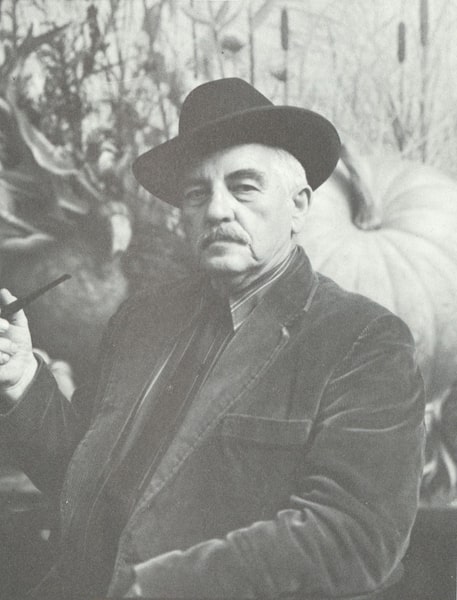Paul Lantz’s art career was fast and furious, at least for the first part. He enrolled at the Kansas City Art Institute at the age of fifteen,1 reportedly the youngest student ever enrolled. Two years later, Lantz moved to New York City and worked as a dishwasher to fund his studies at the Art Students League. One version of the story is that after four years, the stock market crash prompted him to board a freight train to Santa Fe. Another version, recorded in Town & Country magazine, is that he hopped a boxcar to the Southwest after he “too enthusiastically” witnessed a Communist meeting in Union Square.2 In any event, he made his way to New Mexico, his connection to the state being that of Taos Society of Artists member Randall Davey, who had been his teacher in Kansas City. Davey would continue to mentor Lantz and help to facilitate his career for the next decade.
Lantz lived and painted in Santa Fe and Albuquerque from 1930 to 1939, and in that time left a lasting mark. Lantz’s career operated on two parallel tracks. His living was mostly made as a commercial artist, creating murals and embellishing furniture for La Fonda Hotel, fulfilling portrait commissions, restoring church frescoes, and painting the “Toyland” set for the town of Madrid’s famous Christmas display. At the same time, he pursued his career as a “fine” artist. In 1933, he helped found the Rio Grande Painters, a modernist artist society that successfully organized shows across the state for several years.
During the New Deal, Lantz was first employed by the Public Works of Art Project as an easel painter. He made landscapes and scenes of Cabeza de Vaca’s exploits to hang in government buildings. Lantz was later employed by the Federal Art Project and in this capacity painted a mural for the Clovis Post Office between 1937 and 1938. Though he made a research trip to Clovis to prepare for the project, the subject matter of which was the history of Clovis, Lantz’s mural was criticized by locals for its lack of accuracy. “Old timers [attacked] it . . . saying that some of the buildings are in the wrong places and that a water trough, a conspicuous object on the street in the early days, has been omitted entirely from the picture. Others have attacked the appearance of a horse in the mural,” saying that it looked like it only had three legs. The Clovis News-Journal pointed out that “the animal’s position indicates that the [horse] is single-footing—something a cowboy would not tolerate.”3 Despite such thorough scrutiny, in 1939 Lantz’s art was chosen to represent New Mexico at both the New York World’s Fair and the Golden Gate International Exposition in San Francisco.
In 1940, to fund a trip to New York City for a show of his work in a Park Avenue gallery, Lantz incorporated himself and sold fifty shares for $10 each in “Paul Lantz Inc.”4 It is unclear if this enterprising move paid off. From New York, Lantz sent a painting back to Santa Fe to be sold at the Museum of New Mexico Art Gallery for $500, with the proceeds going to his shareholders as “dividends.” Lantz’s business ventures ultimately led to his divorce, and in a 1942 court filing, his wife declared the couple “broke.”5
The second half of Lantz’s career involved travel and mostly commercial artistic production. Lantz served as an artist in the Army during World War II and moved to California afterward. He then spent a decade on a farm in upstate New York and a few years in Mexico City. During this time, he worked as a book illustrator, illustrating more than twenty-five books including the 1942 Newberry Medal winner The Matchlock Gun by Walter D. Edmonds and Little Navajo Bluebird by Ann Nolan Clark. Once he decided to start painting “seriously” again, it was only a few years before he returned to Santa Fe permanently in 1973.
In a 1976 Southwestern Art article, Lantz’s contemporary John Jellico characterized him as a “Modern Old Master,” noting the color, dynamism and “fine pattern of movement” within his work.6


